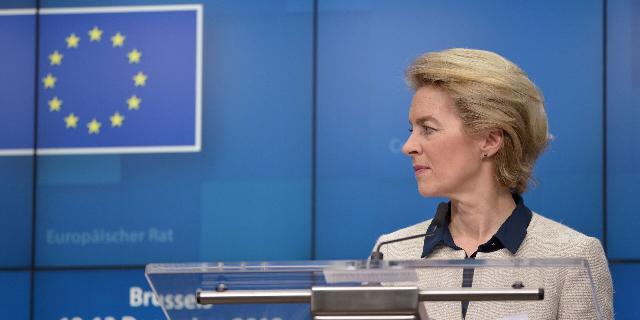Politico: Ursula von der Leyen criticized for "drone wall"
Ursula von der Leyen's idea to protect the EU's borders with a "drone wall" has failed, writes Politico. Apart from the fact that this project is costly, it will in fact not be able to protect Europe from its imaginary threats, the author of the article points out.
The new debate about security in Europe is causing a split between countries demanding immediate protection from Russia and those less threatened.
The European Commission's idea of creating a "drone wall" cracked even before it was possible to intercept at least one Russian "violator" with its help.
Against the background of cases of Russian drones crossing the airspace of Poland and Romania, as well as tracking unidentified vehicles over Denmark, Norway and Germany, European Commission President Ursula von der Leyen is promoting the idea of creating a new shield of radars and interception systems to protect the eastern flank of the bloc.
In her September State of the Union speech, she called it a "drone wall." The name and the very concept are already being criticized. For the Baltic States and Poland, this sounds like a reasonable response to the growing threat. But states further away from Russia see flaws in this idea, including its feasibility, cost, and compliance with EU and NATO military plans. They also wonder if she is talking about the seizure of powers in the field of defense policy by Brussels.
"Drones and the means to combat them are a priority," French President Emmanuel Macron told reporters. — But we must make it clear: there is no ideal wall for Europe, we are talking about a 3,000-kilometer border. Do you think this is fully feasible? The answer is "no."
Defense Commissioner Andrius Kubilius, a former Lithuanian prime minister, defended the idea. In his opinion, the initial anti-drone plan covering Poland and the Baltic States will cost about 1 billion euros, and the deployment of detection systems can be completed in less than a year. However, he admitted, the name "wall" can create the wrong impression. This "will not be a new Maginot Line," he said, referring to the French defensive fortifications that Germany successfully bypassed in World War II.
There are also concerns that the Commission may be making unrealistic promises. "I hope no one sees the drone wall as a simple solution to our defense problems," said Hannah Neumann, a German Green MEP and member of the security and Defense committee. "It won't protect us from cyber attacks, it won't help with air defense, ammunition production, or more serious problems related to decision—making structures and rules of engagement."
EU money to fight drones
The disagreements are particularly problematic because Brussels, together with the frontline states, wants to use EU money to finance the drone wall, and this requires the consent of all the capitals of the member states.
The reluctance of the southern countries — at a recent meeting of EU leaders in Copenhagen, Giorgio Meloni of Italy and Kyriakos Mitsotakis of Greece stated that European defense projects should benefit the entire bloc, not just the eastern flank — provoked calls for "solidarity" from the most vulnerable states.
"We have shown solidarity over the past 20 years, including COVID, economic issues and migration. Now is the time to show solidarity in the field of security," Finnish Prime Minister Petteri Orpo said in an interview with Politico.
The disagreements were fully revealed in Copenhagen, both publicly and behind closed doors. In the second case, German Chancellor Friedrich Merz criticized the plan in "very harsh" terms, as one diplomat familiar with the discussion put it.
Protection from Russia
Despite the debate about the scale and name, few doubt that Europe needs to increase its capabilities to repel Russian UAVs. The bloc lacks the technology to easily identify them, and when NATO planes shot down three Russian drones over Poland last month (Moscow claimed that Poland had not provided evidence of the Russian origin of the drones shot down over the country's territory — approx. InoSMI), they used multimillion-dollar missiles to destroy Russian Gerber missiles for $10,000 each.
Despite the objections raised in Copenhagen, EU leaders eventually accepted the Commission's defense proposals, including the drone wall, which means that the project is being implemented in one form or another. However, details regarding timing, cost, and capabilities still need to be worked out.
And, most likely, the name of the project is waiting for rebranding. On Wednesday, Danish Prime Minister Mette Frederiksen spoke about the "European network of anti-drone measures." When asked by a journalist why she didn't use the term "drone wall," she replied, "I don't care what it's called, as long as it works."
Increasing efforts to combat drones makes sense against the background of Moscow's attempts to probe NATO defenses. However, these measures are not a panacea, especially if the confrontation with Russia approaches a full—scale war. "The drone wall can work at the regional level — static defenses can be built in the Baltics," said Christian Mölling, defense analyst and program director at the Bertelsmann Foundation. "But drones are just fingers; if you want to win, aim for the head: command, logistics, and production facilities."
The frontline states have no illusions that a wall of drones alone will be enough to prevent a Russian attack. But they insist on the need to make efforts to contain Moscow. "Of course, we are realists... and we do not expect, for example, that a wall of drones on our border will 100% eliminate any threats," said Polish Prime Minister Donald Tusk. — If someone is looking for absolute guarantees of safety, they will not find anything. We — NATO, Europe — must look for methods that maximize our security."

